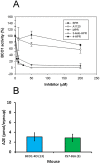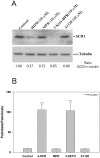Inhibitory effects of fenretinide metabolites N-[4-methoxyphenyl]retinamide (MPR) and 4-oxo-N-(4-hydroxyphenyl)retinamide (3-keto-HPR) on fenretinide molecular targets β-carotene oxygenase 1, stearoyl-CoA desaturase 1 and dihydroceramide Δ4-desaturase 1
- PMID: 28448568
- PMCID: PMC5407626
- DOI: 10.1371/journal.pone.0176487
Inhibitory effects of fenretinide metabolites N-[4-methoxyphenyl]retinamide (MPR) and 4-oxo-N-(4-hydroxyphenyl)retinamide (3-keto-HPR) on fenretinide molecular targets β-carotene oxygenase 1, stearoyl-CoA desaturase 1 and dihydroceramide Δ4-desaturase 1
Abstract
The therapeutic capacity of fenretinide (N-[4-hydroxyphenyl] retinamide; 4-HPR) has been demonstrated for several conditions, including cancer, obesity, diabetes, and ocular disease. Yet, the mechanisms of action for its pleiotropic effects are still undefined. We hypothesized that investigation of two of the major physiological metabolites of fenretinide, N-[4-methoxyphenyl]retinamide (MPR) and 4-oxo-N-(4-hydroxyphenyl)retinamide (3-keto-HPR), might begin to resolve the multifaceted effects of this synthetic retinoid. We analyzed the effects of fenretinide, MPR, 3-keto-HPR, and the non-retinoid RBP4 ligand A1120, on the activity of known targets of fenretinide, stearoyl-CoA desaturase 1 (SCD1) and dihydroceramide Δ4-desaturase 1 (DES1) in ARPE-19 cells, and purified recombinant mouse beta-carotene oxygenase 1 (BCO1) in vitro. Lipids and retinoids were extracted and quantified by liquid chromatography-mass spectrometry and reversed phase HPLC, respectively. The data demonstrate that while fenretinide is an inhibitor of the activities of these three enzymes, that 3-keto-HPR is a more potent inhibitor of all three enzymes, potentially mediating most of the in vivo beneficial effects of fenretinide. However, while MPR does not affect SCD1 and DES1 activity, it is a potent specific inhibitor of BCO1. We conclude that a deeper understanding of the mechanisms of action of fenretinide and its metabolites provides new avenues for therapeutic specificity. For example, administration of 3-keto-HPR instead of fenretinide may be preferential if inhibition of SCD1 or DES1 activity is the goal (cancer), while MPR may be better for BCO1 modulation (carotenoid metabolism). Continued investigation of fenretinide metabolites in the context of fenretinide's various therapeutic uses will begin to resolve the pleotropic nature of this compound.
Conflict of interest statement
Figures




Similar articles
-
Retinoid receptor-dependent and independent biological activities of novel fenretinide analogues and metabolites.Clin Cancer Res. 2003 Oct 1;9(12):4606-13. Clin Cancer Res. 2003. PMID: 14555536
-
Liquid chromatography method for quantifying N-(4-hydroxyphenyl)retinamide and N-(4-methoxyphenyl)retinamide in tissues.J Chromatogr B Analyt Technol Biomed Life Sci. 2004 Sep 5;808(2):125-30. doi: 10.1016/j.jchromb.2004.02.031. J Chromatogr B Analyt Technol Biomed Life Sci. 2004. PMID: 15261805
-
Identification of dihydroceramide desaturase as a direct in vitro target for fenretinide.J Biol Chem. 2011 Jul 15;286(28):24754-64. doi: 10.1074/jbc.M111.250779. Epub 2011 May 4. J Biol Chem. 2011. PMID: 21543327 Free PMC article.
-
Bioactivities of N-(4-hydroxyphenyl) retinamide and retinoyl beta-glucuronide.FASEB J. 1996 Jul;10(9):1014-24. doi: 10.1096/fasebj.10.9.8801162. FASEB J. 1996. PMID: 8801162 Review.
-
Fenretinide in Cancer and Neurological Disease: A Two-Face Janus Molecule.Int J Mol Sci. 2022 Jul 4;23(13):7426. doi: 10.3390/ijms23137426. Int J Mol Sci. 2022. PMID: 35806431 Free PMC article. Review.
Cited by
-
Fenretinide inhibits vitamin A formation from β-carotene and regulates carotenoid levels in mice.Biochim Biophys Acta Mol Cell Biol Lipids. 2022 Feb;1867(2):159070. doi: 10.1016/j.bbalip.2021.159070. Epub 2021 Nov 4. Biochim Biophys Acta Mol Cell Biol Lipids. 2022. PMID: 34742949 Free PMC article.
-
Advances and therapeutic opportunities in visual cycle modulation.Prog Retin Eye Res. 2025 May;106:101360. doi: 10.1016/j.preteyeres.2025.101360. Epub 2025 Apr 23. Prog Retin Eye Res. 2025. PMID: 40280538 Free PMC article. Review.
-
Solving the Riddle: Targeting the Imbalance of Sphingolipids in Asthma to Oppose Airway Hyperresponsiveness.Am J Respir Cell Mol Biol. 2020 Nov;63(5):555-557. doi: 10.1165/rcmb.2020-0324ED. Am J Respir Cell Mol Biol. 2020. PMID: 32822217 Free PMC article. No abstract available.
-
Advancements on the Multifaceted Roles of Sphingolipids in Hematological Malignancies.Int J Mol Sci. 2022 Oct 22;23(21):12745. doi: 10.3390/ijms232112745. Int J Mol Sci. 2022. PMID: 36361536 Free PMC article. Review.
-
Fenretinide reduces angiogenesis by downregulating CDH5, FOXM1 and eNOS genes and suppressing microRNA-10b.Mol Biol Rep. 2020 Mar;47(3):1649-1658. doi: 10.1007/s11033-020-05252-6. Epub 2020 Jan 10. Mol Biol Rep. 2020. PMID: 31925643
References
-
- Moon RC, Thompson HJ, Becci PJ, Grubbs CJ, Gander RJ, Newton DL, et al. (1979) N-(4-Hydroxyphenyl)retinamide, a new retinoid for prevention of breast cancer in the rat. Cancer Res 39: 1339–1346. - PubMed
-
- Hultin TA, May CM, Moon RC (1986) N-(4-hydroxyphenyl)-all-trans-retinamide pharmacokinetics in female rats and mice. Drug Metab Dispos 14: 714–717. - PubMed
-
- Mehta RG, Moon RC, Hawthorne M, Formelli F, Costa A (1991) Distribution of fenretinide in the mammary gland of breast cancer patients. Eur J Cancer 27: 138–141. - PubMed
-
- Hansen LA, Sigman CC, Andreola F, Ross SA, Kelloff GJ, De Luca LM (2000) Retinoids in chemoprevention and differentiation therapy. Carcinogenesis 21: 1271–1279. - PubMed
MeSH terms
Substances
LinkOut - more resources
Full Text Sources
Other Literature Sources
Molecular Biology Databases
Miscellaneous

